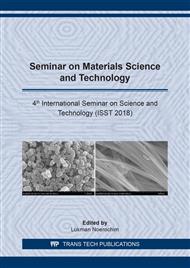[1]
Tran Nguyen P L, Woo Go A, Huynh L H, Ju Y-H. (2013). A study on the mechanism of subcritical water treatment to maximize extractable cellular lipids,. Biomass and Bioenergy. 59:532-539.
DOI: 10.1016/j.biombioe.2013.08.031
Google Scholar
[2]
Zhu L, Nugroho YK, Shakeel SR, Li Z, Martinkauppi B, Hiltunen E. (2017). Using microalgae to produce liquid transportation biodiesel: What is next?,. Renewable Sustainable Energy Reviews. 78:391-400.
DOI: 10.1016/j.rser.2017.04.089
Google Scholar
[3]
Zhou D, Qiao B, Li G, Xue S, Yin J. (2017). Continuous production of biodiesel from microalgae by extraction coupling with transesterification under supercritical conditions,. Bioresource Technology. 238:609–15.
DOI: 10.1016/j.biortech.2017.04.097
Google Scholar
[4]
Hasnain S, Ahmed I, Rizwan M, Rashid N, Mahmood Q, Ali F, et al. (2018). Potential of microalgal biodiesel production and its sustainability perspectives in Pakistan,. Renewable Sustainable Energy Reviews. 8176-92.
DOI: 10.1016/j.rser.2017.07.044
Google Scholar
[5]
Tan XB, Lam MK, Uemura Y, Lim JW, Wong CY, Lee KT. (2018). Cultivation of microalgae for biodiesel production : A review on upstream and downstream processing,. Chinese Journal of Chemical Engineering. 26:17-30.
DOI: 10.1016/j.cjche.2017.08.010
Google Scholar
[6]
Shumbulo E, Ki D. (2018) Microalgae to biofuels : Promising alternative and renewable energy, review,. Renewable Sustainable Energy Reviews. 81:743-55.
DOI: 10.1016/j.rser.2017.08.042
Google Scholar
[7]
Chen J, Li J, Dong W, Zhang X, Tyagi R D, Drogui P, et al. (2018). The potential of microalgae in biodiesel production,. Renewable and Sustainable Energy Reviews. 90:336-46.
DOI: 10.1016/j.rser.2018.03.073
Google Scholar
[8]
Roux J-M, Lamotte H, Achard J-L. (2017). An overview of microalgae lipid extraction in a biorefinery framework,. Sustainable Solutions for Energy and Environment, EENVIRO 2016. 112:680-88.
DOI: 10.1016/j.egypro.2017.03.1137
Google Scholar
[9]
Reddy H K, Muppaneni T, Sun Y, Li Y, Ponnusamy S, D. Patil P, et al. (2014). Subcritical water extraction of lipids from wet algae for biodiesel production,. Fuel. 133:73-81.
DOI: 10.1016/j.fuel.2014.04.081
Google Scholar
[10]
Reddy H K, Muppaneni T, Ponnusamy S, Sudasingle N, Pegallapati A, Selvaratnam T, et al. (2016). Temperature effect on hydrothermal liquefaction of nannochloropsis gaditana and chlorella sp.,. Applied Energy. 165:943-51.
DOI: 10.1016/j.apenergy.2015.11.067
Google Scholar
[11]
Caporgno M P, Pruvost J, legrand J, Lepine O, Tazerout M, Bengoa C. (2016). Hydrothermal liquefaction of nannochloropsis oceanica in different solvents,. Bioresource Technology. 214:404-10.
DOI: 10.1016/j.biortech.2016.04.123
Google Scholar
[12]
Thiruvenkadam S, Izhar S, Yoshida H, K.Danquah M, Harun R. (2015). Process application of subcritical water extraction (SWE) for algal bio-products and biofuels production,. Applied Energy. 154:815-28.
DOI: 10.1016/j.apenergy.2015.05.076
Google Scholar
[13]
Bligh, E.G & dyer W.J. (1959). A rapid method of total lipid extracton and purification., Manuscript received February 27, 1959. Contribution from the Fisheries Research Board of Canada, Technological Station, Halifax, Nova Scotia. Can. J. Biochem. Physiol. Vol. 37.
DOI: 10.1139/o59-099
Google Scholar
[14]
Park J, Kim B, Chang Y K, W.Lee J. (2017). Wet in situ transesterification of microalgae using ethyl acetate as a co-solvent and reactant,. Bioresource and Technology. 230:8-14.
DOI: 10.1016/j.biortech.2017.01.027
Google Scholar
[15]
Halim, Ronald et al, (2012). Extraction of oil from microalgae for biodiesel production: A review., Biotechnology Advances. 30:709–732.
DOI: 10.1016/j.biotechadv.2012.01.001
Google Scholar
[16]
Lu et al, (2015). Characteristics of lipid extraction from Chlorella sp. cultivated in outdoor raceway ponds with mixture of ethyl acetate and ethanol for biodiesel production,. Bioresource Technology. 191:433–437.
DOI: 10.1016/j.biortech.2015.02.069
Google Scholar


